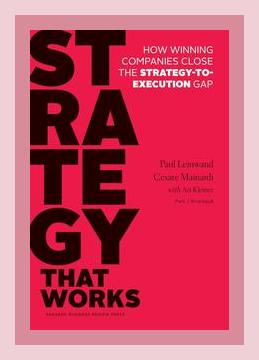Leadership and ManagementStrategic Leadership
Introduction
“Strategy That Works: How Winning Companies Close the Strategy-to-Execution Gap” by Paul Leinwand and Cesare Mainardi addresses a critical issue in strategic management: bridging the gap between strategy and execution. The book identifies five key practices that successful companies use to effectively align their strategies with execution, ensuring that their strategic aspirations are realized in practice.
1. Commit to an Identity
Major Point: Successful companies have a clear and distinctive identity. This identity is a combination of three interlinked elements: a value proposition, a customer promise, and a set of distinctive capabilities.
Examples and Actions:
– Amazon: Amazon commits to being “the most customer-centric company on earth.” This identity drives all its strategic decisions, from technological investments to service design.
Action: Define the core elements of your company’s identity by conducting a workshop with key stakeholders. Focus on articulating your value proposition, customer promise, and distinctive capabilities, ensuring all strategies align with this identity.
- IKEA: IKEA’s identity centers around providing well-designed, functional home furnishings at low prices. This identity is evident in everything from its supply chain logistics to its store layout.
Action: Conduct a thorough review of all aspects of your operations to ensure they reflect and reinforce your identity. If discrepancies are found, develop a plan to realign these elements.
2. Translate the Strategic into the Everyday
Major Point: Strategies need to be operationalized into everyday activities and decisions. Successful companies make sure that their strategic priorities drive the actions and decisions at every level of the organization.
Examples and Actions:
– Apple: Apple’s obsession with design excellence isn’t just a strategic declaration but is reflected in detailed execution across all levels, from product development to marketing.
Action: Break down strategic goals into specific, measurable, and attainable action items for each department, ensuring alignment with overarching strategic objectives.
- Zara: Zara translates its strategy of fast fashion into precise operational actions – quick design-to-shelf turnaround, high product turnover, and tight control over supply chains.
Action: Implement continuous improvement cycles where teams regularly evaluate their alignment with strategic priorities and make necessary adjustments.
3. Put Your Culture to Work
Major Point: The culture of an organization should be leveraged as a tool to drive strategy. Successful companies ensure that their culture supports and enhances their strategic goals.
Examples and Actions:
– Southwest Airlines: Southwest’s culture of employee empowerment and customer service is integral to its strategy of low-cost, high-efficiency air travel.
Action: Identify key cultural attributes that support your strategy. Reinforce these attributes through targeted hires, training programs, and recognition systems.
- Procter & Gamble (P&G): P&G’s culture of innovation is cultivated by creating cross-functional teams that work on new product development, aligning with their strategic focus on consumer-driven innovation.
Action: Foster a culture that aligns with strategic goals by creating cross-departmental initiatives that encourage collaboration and innovation.
4. Cut Costs to Grow Stronger
Major Point: Strategic cost management focuses on cutting costs in areas that do not impact the core capabilities of a company. This redirects resources to areas that enhance the company’s unique value proposition.
Examples and Actions:
– GE: Under Jack Welch, GE cut costs aggressively in non-core areas while investing in technologies and sectors aligned with its strategic priorities.
Action: Conduct a cost analysis to identify non-essential expenditures. Develop a plan to reduce these costs and redirect savings towards enhancing core capabilities.
- Nestlé: Nestlé systematically reduces costs in its supply chain to free up resources for brand-building and innovation.
Action: Implement a zero-based budgeting approach where every expense must be justified each year, ensuring alignment with strategic priorities.
5. Shape the Future
Major Point: Leading companies do not just react to the future; they actively shape it. This involves making bold moves, exploring new business models, and creating capabilities that anticipate future market needs.
Examples and Actions:
– Google: Google’s investments in diverse areas like artificial intelligence, autonomous vehicles, and healthcare reflect its strategy to shape the future by broadening its scope of innovation.
Action: Establish an innovation committee that focuses on emerging trends and technologies. Allocate a portion of your budget to fund exploratory projects and partnerships.
- Tesla: Tesla shapes the future of transportation with its continuous innovations in electric vehicles and renewable energy solutions.
Action: Develop a strategic foresight team responsible for identifying future trends and integrating them into the company’s long-term planning.
Conclusion
“Strategy That Works” provides a robust framework for companies aiming to close the gap between strategy and execution. Successful implementation hinges on a company’s ability to commit to a clear identity, translate strategy into daily operations, leverage culture, manage costs strategically, and proactively shape the future. Each of these practices is illustrated with concrete examples from leading companies, providing actionable insights that any business leader can apply.
Concrete Actions Recap:
- Commit to an Identity:
- Define core elements of identity through stakeholder workshops.
-
Align operations with identity and realign if discrepancies are found.
-
Translate the Strategic into the Everyday:
- Break down strategic goals into departmental action items.
-
Implement continuous improvement cycles for regular alignment checks.
-
Put Your Culture to Work:
- Identify and reinforce key cultural attributes.
-
Foster cross-departmental collaboration aligned with strategy.
-
Cut Costs to Grow Stronger:
- Conduct cost analyses to identify non-essential expenditures.
-
Use zero-based budgeting for strategic alignment of expenses.
-
Shape the Future:
- Establish an innovation committee for trend exploration.
- Form a strategic foresight team to integrate future trends into planning.
By following these practices, companies can improve their strategic execution and achieve sustainable growth and competitive advantage.
